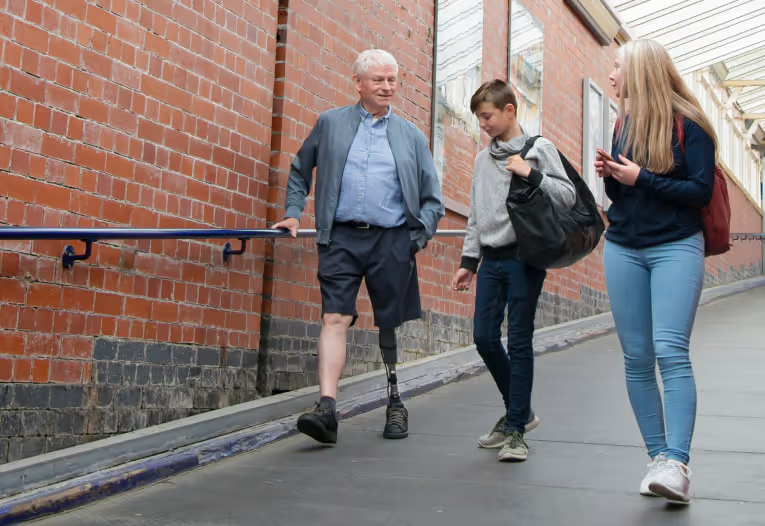If you or someone you know is adapting to life with a prosthetic leg, the question, "How do people sleep with a prosthetic leg?" or "Can you sleep with a prosthetic arm?" is likely a concern that comes to mind. Learning about the pros and cons of keeping a prosthetic leg on while sleeping can influence both your well-being and overall quality of life. In this comprehensive guide, our experts at PrimeCare will offer pragmatic advice to address this important issue.
Advantages of Sleeping Without a Prosthetic Leg

Before you make a decision about whether or not to sleep with your prosthetic limb, make sure to weigh the benefits of going without it at night.
Reduced Wear & Tear on the Device
One of the most prominent benefits of removing your prosthetic leg before bedtime is the potential for reduced wear and tear on the device. Prosthetic limbs are sophisticated pieces of medical equipment that can undergo significant stress through daily usage. By taking off your prosthetic leg during sleeping hours, you provide it with a “rest period” that can extend its lifespan and reduce the frequency of necessary repairs or replacements.
Better Circulation
The human body is designed to optimize blood flow when in a relaxed state, and the same logic applies to those with lower limb prosthetics. Removing your prosthetic leg for sleep can improve your overall blood circulation and contribute to better bodily functions. It also minimizes the risks associated with poor circulation such as blood clots or vascular diseases.
Lower Risk of Skin Irritation
Prosthetic legs can be irritating to the skin. Wearing a prosthetic leg for an extended period may result in skin irritation due to friction and reduced airflow. When you choose to sleep without your prosthetic limb, you give your skin the chance to breathe. This reduced contact time with the prosthetic's materials can minimize the likelihood of developing skin issues such as chafing, sores, or even infections.
Disadvantages of Sleeping Without a Prosthetic Leg
While there are benefits to removing your prosthetic leg for sleep, there are also some drawbacks worth considering.
Difficulty in Emergency Situations
In the event of an emergency that requires quick action, not having your prosthetic leg on can create complications. For example, if you need to evacuate your residence immediately, the time it takes to attach your prosthetic limb could be critical.
Psychological Factors
Another important consideration is the psychological impact of limb loss, which can be exacerbated when the limb lays separate from the body during sleep. For some people, removing their prosthetic leg amplifies feelings of incompleteness or vulnerability, which can disrupt emotional well-being and reduce the chances of a good night's sleep.
Tips for Achieving a Good Night's Sleep as an Amputee
There's no denying that sleep is a cornerstone of overall health and well-being. However, sleeping soundly can be particularly challenging for individuals adjusting to life with a prosthetic. In this part of the guide, we'll share some actionable tips and strategies specifically tailored for amputees to help you achieve a restorative night's sleep.

#1. Get Comfortable in Bed
The position in which you sleep can dramatically affect the quality of your rest. Especially for those with a lower limb difference, it's crucial to avoid hip flexion contracture, a condition that can occur when the hip doesn't completely straighten. For above-the-knee amputees, sleeping with a pillow between the legs can alleviate pressure on the inner thigh muscle and outer thigh muscle, ensuring your prosthetic limb fits well the next day.
#2. Keep a Regular Bedtime for a Better Circadian Rhythm
It's important to wake up and fall asleep at consistent times to regulate your body's internal clock. This helps you adapt to the rhythms of everyday life and makes it easier to fall asleep when it's time to rest.
#3. Shower Before Bed
Hot showers can cause swelling in an amputated limb, which makes it difficult for prosthetic limbs to fit as they should. To avoid this challenge, you might consider taking your shower in the evening to help ensure a better fit for your prosthetic the following day.
If you're the type who can't forgo your morning shower, opting for a cold shower instead can help prevent swelling in the amputated limb and ensure a more comfortable fit for your prosthetic.
#4. Exercise the Right Way

Engaging in the right exercises not only boosts your strength but also enhances your posture, balance, and muscle tone. For those with prosthetic legs, regular workouts can help alleviate back pain and offer better support for your body weight. For example, there are exercise techniques specifically designed to focus on the body's center of gravity to aid amputees in better orienting and thriving with their prosthetic devices.
Achieving Better Sleep and Optimal Well-Being with Prosthetics
Navigating the intricacies of life after an above-the-knee amputation can be a challenging journey, but it's possible to find comfort and achieve better sleep. By implementing the actionable tips in this guide, you're on the right path toward improving your quality of life.
If you require a prosthetic device, PrimeCare offers world-class workmanship and clinical expertise at our state-of-the-art prosthetic clinic in Las Cruces. If you need a high-quality prosthetic, feel free to contact us at PrimeCare to explore your options.

.svg)
.svg)






